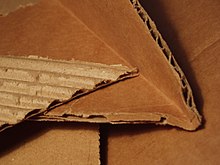Containerboard

Containerboard or corrugated case material (CCM) is a type of
Manufacture
Containerboard is made on modified paper machines that can handle higher grammages.
The production of containerboard is the highest of all kinds of paper in the world.[citation needed] More than 100 million tons are produced annually.[citation needed] It is made in specialized paper machines from virgin as well as recycled fibers. Linerboard made of virgin pulp is called kraftliner, whereas recycled linerboard is known as testliner. The corrugating medium may be recycled medium, called wellenstoff in Europe, or virgin, which is called semichemical medium for the type of pulp used in its production. The borders of these categories becomes blurred when both virgin and recycled fibers are used in making one product.
At the end of the manufacturing process containerboard is cut into rolls comprising a continuous sheet of paper, which will later be unwound in the corrugator machine while making the corrugated board. A typical roll has a width of 2.5 m (8 ft 2 in), a diameter of 1.45 m (4 ft 9 in), and weighs around 3,000 kg (6,610 lb).
